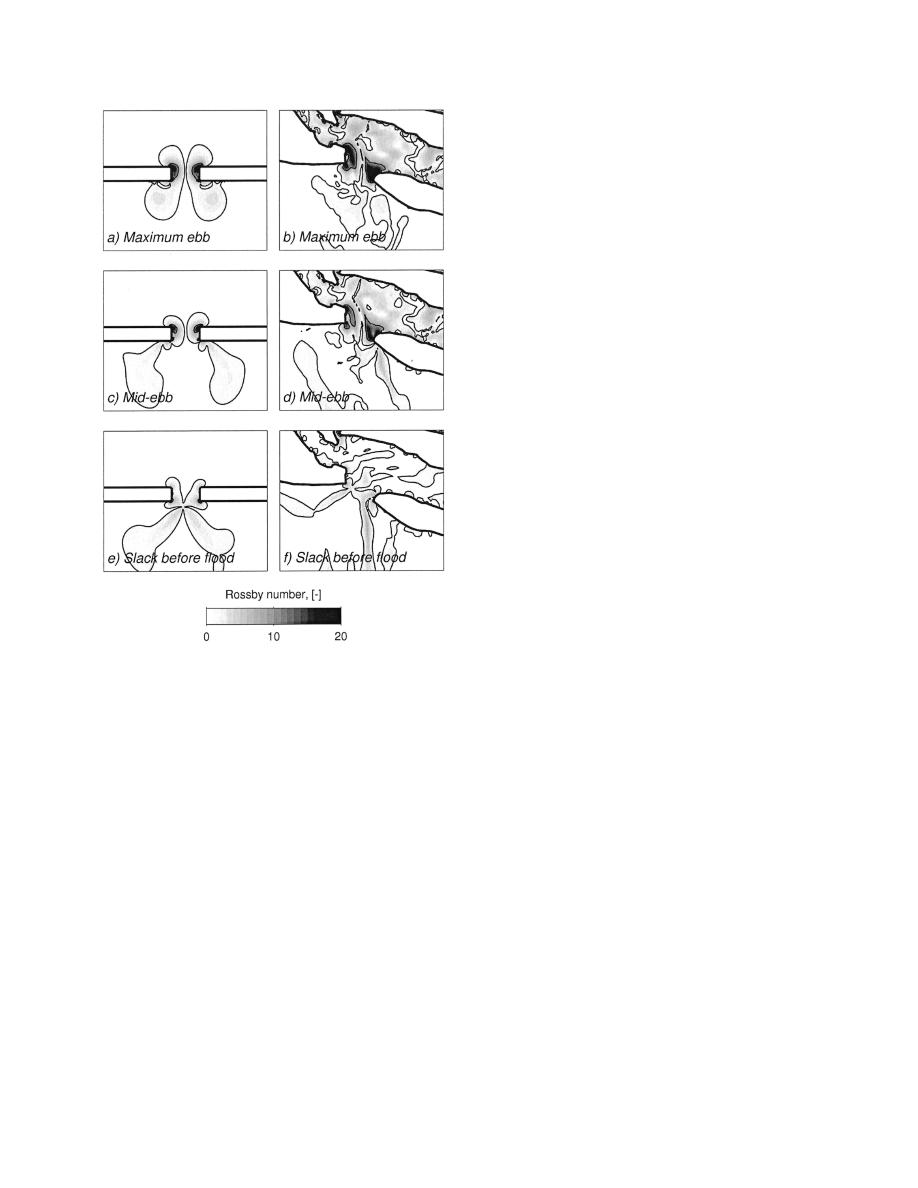
927
APRIL 2003
HENCH AND LUETTICH
scale offshore streamwise pressure gradient g / s turns
from favorable to adverse and acts to ``brake'' the flow,
resulting in negative Us / t. Along the jet sides, the flow
is sufficiently weak that the time required to ``brake''
the flow is less than that for the jet, and therefore switch-
es sooner to flood and positive Us/ t. The difference
in the time it takes the flood adverse pressure gradient
to turn the tide from the jet relative to the sides is the
source of the phase lag. This same general behavior was
seen at Beaufort Inlet, but the offset inlet headlands
acting in conjunction with phase lags within the sound
produced an asymmetric flood flow pattern, with the
eastern side of the inlet flooding first.
The transient eddies are largely responsible for inlet
exchange of sound water with ocean water, as illustrated
with modeled particle trajectories in Fig. 12. Early in
the flood the offshore streamwise pressure gradient
drives flow along the ocean shoreline and into the inlet
(Figs. 12e,f). While the ebb jet continues to spin down
offshore, ocean water (which may be ``new'' or a diluted
mixture of estuarine and ocean water from previous
ebbs) flows behind it and isolates water contained in the
ebb jet. Therefore one would expect initial flood water
at an inlet to have a higher salinity than found at mid-
flood, with salinities increasing again during late flood.
This generic picture is somewhat altered at Beaufort
Inlet as ocean water preferentially enters the east side
of the inlet.
b. Implications for cross-inlet exchange
While it is clear that significant mixing and exchange
occurs at tidal inlets, as described above, the results of
FIG. 11. (a)(f ) Rossby number (defined as Ro | Us/ fRs | ) shaded
this study show that this notion should be qualified in
contours at various phases of the tide. The solid black contour lines
the cross-inlet direction. During the stronger phases of
1 and Ro
10.
indicate Ro
the tide, the primary lateral balance within the inlet is
between centrifugal acceleration and lateral pressure
gradients. The centrifugal acceleration is greatest near
a. Transient eddies and oceansound exchange
the headland tips, and approaches zero at the inlet center
(where streamlines become straight and Rs approaches
The transient eddies which form behind the headland
features at shallow inlets have been described as phase
infinity). The water surface adjusts by dipping near the
eddies to distinguish them from recirculations due to
headland tips and sloping upward toward the inlet cen-
pure flow separation (Black and Gay 1987). These au-
ter, forming a dome of water across the inlet. The sig-
thors proposed that the phase lags between flow in the
nificance of this is that the sign of the lateral pressure
center of the inlet and the inlet sides were due to en-
gradient changes from one side of the inlet to the other
hanced bottom friction on the shallow ebb shoals and
(i.e., opposing pressure gradients push against each oth-
reduced bottom friction in the deep main channel. The
er much in the same way a solid boundary opposes the
results from the idealized inlet in this study (with uni-
centrifugal acceleration in the case of a river bend).
form alongshore bathymetry) suggest that spatial dif-
Since the barotropic pressure gradient is uniform with
ferences in bottom friction are not needed to generate
depth, these forces constrain flow to remain on the side
these phase lags. Rather the generation mechanism for
of the inlet that it entered the inlet on. We expect this
the phase eddies is ``headland sheltering'' of momentum
``dynamical wall effect'' to significantly restrict lateral
(from the ebb jet) along the sides of the inlet. At max-
mixing within an inlet. Modeled inlet drifter trajectories
imum ebb, the ebb jet contains strong Us Us / s (locally
for the idealized inlet and Beaufort Inlet clearly illustrate
balanced by bottom friction), while on both sides of the
this effect as they are turned around the headland fea-
jet, Us Us/ s is weak. Toward the end of ebb, the jet
tures, but not across the inlets (see Figs. 12gj). Previous
does not spin down completely under the influence of
observed (Churchill et al. 1999) and model (Luettich et
bottom friction, as a free jet would. Instead, the large-
al. 1999; Brown et al. 2000) drifter studies also exhib-




 Previous Page
Previous Page
